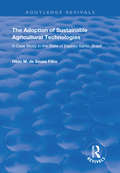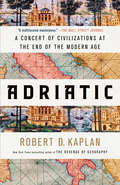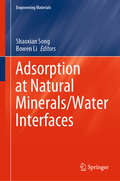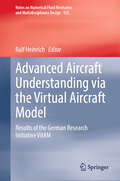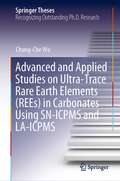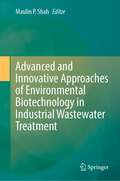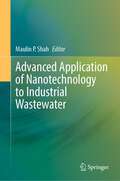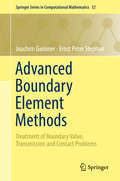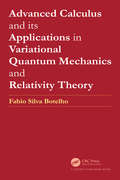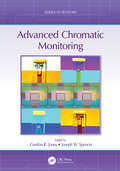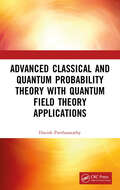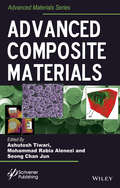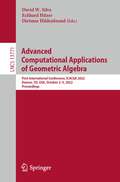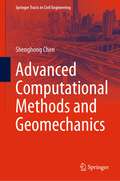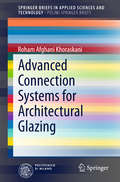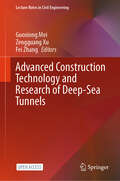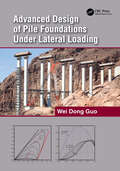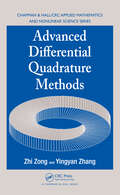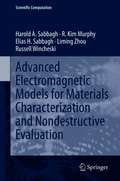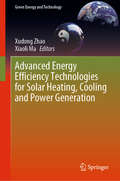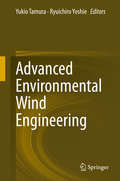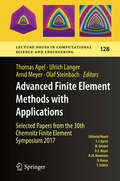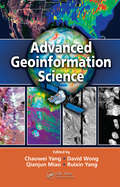- Table View
- List View
The Adoption of Sustainable Agricultural Technologies: A Case Study in the State of Espírito Santo, Brazil (Routledge Revivals)
by Hildo Meirelles FilhoFirst published in 1997, this volume reflects concern about the environmental impact of modern agricultural practices, agriculture's increasing reliance on non-renewable resources, and the long-term productivity of high external-input agricultural systems which has prompted a number of initiatives to promote the adoption and diffusion of more sustainable technologies. For these interventions to be effective, they should be based on an understanding of what induces the producer to switch from conventional to alternative practices. This book provides a review on the determinants of adoption and diffusion of sustainable agricultural technologies, including concepts and theories related to this theme. The Green Revolution in Brazil is examined as a means of establishing the background for an empirical investigation. Data about farms in the State of Espírito Santo are analysed using duration analysis, an econometric technique which allows to assess the impact of time-varying, economic variables. Thus, adoption is explained as a dynamic process.
Adriatic: A Concert of Civilizations at the End of the Modern Age
by Robert D. Kaplan&“[An] elegantly layered exploration of Europe&’s past and future . . . a multifaceted masterpiece.&”—The Wall Street Journal&“A lovely, personal journey around the Adriatic, in which Robert Kaplan revisits places and peoples he first encountered decades ago.&”—Peter Frankopan, author of The Silk RoadsIn this insightful travelogue, Robert D. Kaplan, geopolitical expert and bestselling author of Balkan Ghosts and The Revenge of Geography, turns his perceptive eye to a region that for centuries has been a meeting point of cultures, trade, and ideas. He undertakes a journey around the Adriatic Sea, through Italy, Slovenia, Croatia, Montenegro, Albania, and Greece, to reveal that far more is happening in the region than most news stories let on. Often overlooked, the Adriatic is in fact at the center of the most significant challenges of our time, including the rise of populist politics, the refugee crisis, and battles over the control of energy resources. And it is once again becoming a global trading hub that will determine Europe&’s relationship with the rest of the world as China and Russia compete for dominance in its ports. Kaplan explores how the region has changed over his three decades of observing it as a journalist. He finds that to understand both the historical and contemporary Adriatic is to gain a window on the future of Europe as a whole, and he unearths a stark truth: The era of populism is an epiphenomenon—a symptom of the age of nationalism coming to an end. Instead, the continent is returning to alignments of the early modern era as distinctions between East and West meet and break down within the Adriatic countries and ultimately throughout Europe. With a brilliant cross-pollination of history, literature, art, architecture, and current events, in Adriatic, Kaplan demonstrates that this unique region that exists at the intersection of civilizations holds revelatory truths for the future of global affairs.
Adsorption at Natural Minerals/Water Interfaces (Engineering Materials)
by Shaoxian Song Bowen LiThis book introduces the latest research regarding the adsorption of heavy metals, toxic ions, and organic compounds at the interfaces of water/minerals, such as mineralogical characterizations, surface chemistry, and modification of natural minerals as adsorbents, as well as the adsorption of cations, anions, and organic compounds in water. Presenting findings by the authors and their co-workers, the book helps readers grasp the principals and benefits of using minerals for water treatment, as well as the advanced technologies in the area developed over last 30 years, especially the last 10 years.
Advanced Aircraft Understanding via the Virtual Aircraft Model: Results of the German Research Initiative VitAM (Notes on Numerical Fluid Mechanics and Multidisciplinary Design #155)
by Ralf HeinrichThis book reports on the results of a four-year collaborative project between the German Aerospace Center (DLR), three German universities and the aircraft industry. The project was funded by the Ministry for Economic Affairs and Climate Action. In the book, different subprojects are presented, with their corresponding case studies. Readers will find extensive information on simulation strategies required for virtual flight testing, and verification and validation aspects. All in all, this book offers a timely update on the state-of-the-art in flow simulation techniques, flight mechanics methods, integrated multidisciplinary simulation, reduced-order models, and on the development of processes for automated generation of aerodynamic databases. It addresses both researchers and professionals in the field of aviation engineering.
Advanced and Applied Studies on Ultra-Trace Rare Earth Elements (Springer Theses)
by Chung-Che WuThis book provides two state-of-the-art quantitative techniques to determine ultra-trace rare earth elements (REEs) in natural carbonates using solution nebulization-inductively coupled plasma mass spectrometry (SN-ICPMS) and laser ablation-inductively coupled plasma mass spectrometry (LA-ICPMS) with respective applications were presented in this dissertation. These techniques were applied to natural carbonates, including corals and stalagmites, to understand volcano eruptions and the impacts on modern biosystem and paleoclimate regimes. In the first SN-ICPMS protocol, direct measurements for femtogram quantity carbonate samples without chemical separation steps can offer accurate and high-precision analysis (±1.9-6.5%, 2σ) with a high sample throughput of 8-10 samples/hr routinely. Application to modern Porites corals collected from South China Sea region, the anomalies of REE contents and Al/Ca ratios associated with micro-domain images, register modern coral reefs could be exacerbated by volcanic eruptions. In the second protocol, a high-sensitivity quantitative open-cell LA-ICPMS technique has been established to allow direct sampling on stalagmite surface in the atmospheric air. This technique improved limits of detection down to sub-ng/g range and promises analyses of carbonate REE profiles at the single digit parts-per-billion (ppb) levels. Application to a 15-cm stalagmite collected from East Timor reveals two peaks of REE contents by at least one order of magnitude, possibly due to volcanic ash preserved in stalagmite. Both improved SN-ICPMS and LA-ICPMS techniques highlight the high-sensitivity and high-temporal-resolution carbonate REE analyses for corals and stalagmites, with great potential to other natural carbonates such as travertine, tufa, and flowstone, benefit our understanding of paleoclimatic and paleoenvironmental dynamics.
Advanced and Innovative Approaches of Environmental Biotechnology in Industrial Wastewater Treatment
by Maulin P. ShahThis book discusses new and innovative trends and techniques in the removal of toxic and refractory pollutants by means of various microbial biotechnology processes from wastewater, both on the laboratory and industrial scales. The book also highlights the main factors contributing to the removal of toxic pollutants as well as recycling, environmental impact, and wastewater policies after heavy metal removal. In addition, it assesses the potential application of several existing bioremediation techniques and introduces new cutting-edge emerging technologies. This book significantly contributes to the wastewater treatment plant industry so that the treatment systems can serve better and more resiliently for the purpose. This book is designed for engineers, scientists, and other professionals who are seeking introductory knowledge of the principles of environmental bioremediation technology and for students who are interested in the environmental microbiology and bioremediation fields.
Advanced Application of Nanotechnology to Industrial Wastewater
by Maulin P. ShahThis book discusses new and innovative trends and techniques in the application of nanotechnology to industrial wastewater treatment both at a laboratory scale and an industry scale, including treatment, remediation, sensing and pollution prevention. The book also explores unique physicochemical and surface properties of nanoparticles; it highlights advantages they provide for engineering applications. Each chapter covers a different nanotechnology-based approach and examines basic principles, practical applications, recent breakthroughs and associated limitations. Nanotechnology applications to wastewater research have significant impact in maintaining the long-term quality, availability and viability of water. Regardless of the origin—for example, municipal or industrial wastewater—the remediation nanotechnology allows water to be recycled and desalinized in addition to simultaneously detecting biological and chemical contamination. The book describes a broad area of nanotechnology and water research where membrane processes (nanofiltration, ultrafiltration, reverse osmosis and nanoreactive membranes) are considered key components of advanced water purification and desalination technologies that remove, reduce or neutralize water contaminants. Various nanoparticles and nanomaterials that could be used in water remediation (zeolites, carbon nanotubes, self-assembled monolayers on mesoporous supports, biopolymers, single-enzyme nanoparticles, zero-valent iron nanoparticles, bimetallic iron nanoparticles and nanoscale semiconductor photocatalysts) are also discussed. This book is beneficial for students and academicians to understand the recent research advancements in the field.
Advanced Boundary Element Methods: Treatment of Boundary Value, Transmission and Contact Problems (Springer Series in Computational Mathematics #52)
by Ernst Peter Stephan Joachim GwinnerThis book is devoted to the mathematical analysis of the numerical solution of boundary integral equations treating boundary value, transmission and contact problems arising in elasticity, acoustic and electromagnetic scattering. It serves as the mathematical foundation of the boundary element methods (BEM) both for static and dynamic problems. The book presents a systematic approach to the variational methods for boundary integral equations including the treatment with variational inequalities for contact problems. It also features adaptive BEM, hp-version BEM, coupling of finite and boundary element methods – efficient computational tools that have become extremely popular in applications.Familiarizing readers with tools like Mellin transformation and pseudodifferential operators as well as convex and nonsmooth analysis for variational inequalities, it concisely presents efficient, state-of-the-art boundary element approximations and points to up-to-date research.The authors are well known for their fundamental work on boundary elements and related topics, and this book is a major contribution to the modern theory of the BEM (especially for error controlled adaptive methods and for unilateral contact and dynamic problems) and is a valuable resource for applied mathematicians, engineers, scientists and graduate students.
Advanced Calculus and its Applications in Variational Quantum Mechanics and Relativity Theory
by Fabio Silva BotelhoThe first part of this book reviews some key topics on multi-variable advanced calculus. The approach presented includes detailed and rigorous studies on surfaces in Rn which comprises items such as differential forms and an abstract version of the Stokes Theorem in Rn. The conclusion section introduces readers to Riemannian geometry, which is used in the subsequent chapters. The second part reviews applications, specifically in variational quantum mechanics and relativity theory. Topics such as a variational formulation for the relativistic Klein-Gordon equation, the derivation of a variational formulation for relativistic mechanics firstly through (semi)-Riemannian geometry are covered. The second part has a more general context. It includes fundamentals of differential geometry. The later chapters describe a new interpretation for the Bohr atomic model through a semi-classical approach. The book concludes with a classical description of the radiating cavity model in quantum mechanics.
Advanced Chromatic Monitoring (Series in Sensors)
by Gordon R. Jones and Joseph W. SpencerAdvanced Chromatic Monitoring provides a major source of information about the novel approach of chromaticity with examples of how chromaticity may be deployed for various monitoring applications. It shows with examples what can be achieved with chromatic methods in producing relevant information with a variety of test techniques and in facilitating the interpretation of complex data about complicated situations. It will be of interest to postgraduates and researchers in a wide breadth of physical disciplines (engineering, medicine, environmental sciences) and those involved with data acquisition and analysis. Key Features: Applicable to a wide range of disciplines (engineering, medical, environmental, etc) and those interested in science, technology, data acquisition and analysis Provides an extrapolation of new knowledge well beyond that covered in existing literature with regard to dealing with complicated forms and sets of data Addresses inspiring and innovative areas of research including environmental, power delivery and medical monitoring About the Editors: Emeritus Professor Gordon R. Jones – founder and former Director of the Centre for Intelligent Monitoring Systems (CIMS), former Head of the Department of Electrical Engineering and Electronics, and former Director of Electric Arcs Research Group at the University of Liverpool. He was awarded the IEEE Education, Science and Technology Achievement Medal (1999). Professor Joe W. Spencer – the present Director of CIMS at the University of Liverpool, having been Head of the Department of Electrical Engineering and Electronics at Liverpool. He is involved in operating a multi-million pound technology transfer unit (Sensor City, Liverpool) with whose establishment he played a major role and with which CIMS has major interactions.
Advanced Classical and Quantum Probability Theory with Quantum Field Theory Applications
by Harish ParthasarathyThis book is based on three undergraduate and postgraduate courses taught by the author on Matrix theory, Probability theory and Antenna theory over the past several years. It discusses Matrix theory, Probability theory and Antenna theory with solved problems. It will be useful to undergraduate and postgraduate students of Electronics and Communications Engineering. Print edition not for sale in South Asia (India, Sri Lanka, Nepal, Bangladesh, Pakistan and Bhutan).
Advanced Composite Materials
by Mohammad Rabia Alenezi Seong Chan Jun Ashutosh TiwariComposites materials is basically the combining of unique properties of materials to have synergistic effects. A combination of materials is needed to adapt to certain properties for any application area. There is an everlasting desire to make composite materials stronger, lighter or more durable than traditional materials. Carbon materials are known to be attractive in composites because of their combination of chemical and physical properties. In the recent years, development of new composites has been influenced by precision green approaches that restrict hazardous substances and waste created during production. This book ranges from the fundamental principles underpinning the fabrication of different composite materials to their devices, for example, applications in energy harvesting, memory devices, electrochemical biosensing and other advanced composite-based biomedical applications. This book provides a compilation of innovative fabrication strategies and utilization methodologies which are frequently adopted in the advanced composite materials community with respect to developing appropriate composites to efficiently utilize macro and nanoscale features. The key topics are: Pioneer composite materials for printed electronics Current-limiting defects in superconductors High-tech ceramics materials Carbon nanomaterials for electrochemical biosensing Nanostructured ceramics and bioceramics for bone cancer Importance of biomaterials for bone regeneration Tuning hydroxyapatite particles Carbon nanotubes reinforced bioceramic composite Biomimetic prototype interface
Advanced Computational Applications of Geometric Algebra: First International Conference, ICACGA 2022, Denver, CO, USA, October 2-5, 2022, Proceedings (Lecture Notes in Computer Science #13771)
by David W. Silva Eckhard Hitzer Dietmar HildenbrandThis book constitutes the post-conference proceedings of the First International Conference on Advanced Computational Applications of Geometric Algebra, ICACGA 2022, held in Denver, CO, USA, during October 2-5, 2022. The 18 full papers presented in this book together with 12 abstracts of invited talks were carefully reviewed and selected from 24 submissions. The papers are grouped in the following topical sections: geometric applications; computer science applications; technological applications; and applications to physics and mathematics.
Advanced Computational Methods and Geomechanics (Springer Tracts in Civil Engineering)
by Shenghong ChenThe aim of this book is intended, through parallel expounding, to help readers comprehensively grasp the intrinsic features of typical advanced computational methods. These methods are created in recent three decades for the understanding of the post-failure of geo-materials accompanied with discontinuous and finite deformation/dislocation, as well as the violent fluid-structure interaction accompanied with strong distortion of water surface. The strong points and weak points of the formalisms for governing equations, the discretization schemes, the nodal interpolation /approximation of field variables, and their connectivity (via support domains, covers, or enrichments), the basic algorithms, etc., are clarified. Being aware of that the differences in these methods are not so large as at the first glance, this book will help readers to select appropriate methods, to improve the methods for their specific purpose, and to evaluate the reliability/applicability of the outcomes in the hazard evaluation of geotechnical (hydraulic) structures beyond extreme work situation. This book may be looked at as an advanced continuation of “Computational Geomechanics and Hydraulic Structures” by the author (2018) (Springer-Verlag, ISBN 978-981-10-8134-7) which elaborates the fundamental computational methods in geomechanics for the routine design of geotechnical (hydraulic) engineering.
Advanced Connection Systems for Architectural Glazing (SpringerBriefs in Applied Sciences and Technology)
by Roham Afghani KhoraskaniThis book presents the findings of a detailed study to explore the behavior of architectural glazing systems during and after an earthquake and to develop design proposals that will mitigate or even eliminate the damage inflicted on these systems. The seismic behavior of common types of architectural glazing systems are investigated and causes of damage to each system, identified. Furthermore, depending on the geometrical and structural characteristics, the ultimate horizontal load capacity of glass curtain wall systems is defined based on the stability of the glass components. Detailed attention is devoted to the incorporation of advanced connection devices between the structure of the building and the building envelope system in order to minimize the damage to glazed components. An innovative new connection device is introduced that results in a delicate and functional system easily incorporated into different architectural glazing systems, including those demanding maximum transparency.
Advanced Construction Technology and Research of Deep-Sea Tunnels (Lecture Notes in Civil Engineering #490)
by Guoxiong Mei Zengguang Xu Fei ZhangThis open access book focuses on cutting-edge construction techniques for deep-sea tunnels. A world leader in construction technology for deep-sea tunnels and large undersea engineering structures, China has in these years completed several world-renowned undersea tunnel projects, such as the undersea tunnel connecting Shenzhen and Zhongshan, and the Shantou Bay undersea tunnel. The nation also boasts mature technology and enviable scientific research achievements in large-scale shield technology and deep-sea soil hydrostatic surveying. This book intends to provide a review of relevant studies on deep-sea tunnel construction for civil engineers around the globe and equip scholars in related fields of research with a deeper insight into this domain through comprehensive analyses of real-world engineering cases and the most up-to-date research results. The topics of this book include but are not limited to the following:1. Deep-sea survey technology and equipment.2. Complex load characteristics and numerical simulation technology in the marine environment.3. Key technology of immersed tube and shield tunnel construction.4. Deep-sea construction equipment and safety assessment methods.5. Deep-sea positioning, measurement and control technology.
Advanced Design of Pile Foundations Under Lateral Loading
by Wei Dong GuoThis book presents models that capture the nonlinear response of piles subjected to lateral forces. Utilising a consistent approach encompassing new mathematical models, it offers solutions presented as closed-form expressions and underpinned by the same set of 3-5 measurable soil-input parameters. These focus on nonlinear response of mono piles, anchored piles, pile groups, and torsional piles, as well as passive piles subjected to soil movement induced in shearing, sliding slopes or excavation, and earthquake shaking. The models can also be used for pipelines and similar beam structures. Solutions are provided in the form of design charts, with each parameter obtained using available test data and illustrated with real-world cases. The models reveal, for the first time, the mysterious mechanisms of amplification resulting from back-rotation, which have incurred the collapse of structures such as the Showa Bridge and Nicoll Highway, as well as the distortion of piles during earthquakes. Advanced Design of Pile Foundations Under Lateral Loading is ideal for practicing foundation engineers and students at graduate level. Wei Dong Guo is co-founder of Hans Innovation Group and former Associate Professor at the University of Wollongong, Australia. He is a Chartered Professional Engineer and is a Fellow of Engineers Australia by whom he was awarded the 2012 Warren Medal.
Advanced Differential Quadrature Methods (Chapman & Hall/CRC Applied Mathematics & Nonlinear Science)
by null Zhi Zong null Yingyan ZhangModern Tools to Perform Numerical DifferentiationThe original direct differential quadrature (DQ) method has been known to fail for problems with strong nonlinearity and material discontinuity as well as for problems involving singularity, irregularity, and multiple scales. But now researchers in applied mathematics, computational mechanics, and en
Advanced Digital Signal Processing of Seismic Data
by Wail A. MousaSeismic data must be interpreted using digital signal processing techniques in order to create accurate representations of petroleum reservoirs and the interior structure of the Earth. This book provides an advanced overview of digital signal processing (DSP) and its applications to exploration seismology using real-world examples. The book begins by introducing seismic theory, describing how to identify seismic events in terms of signals and noise, and how to convert seismic data into the language of DSP. Deterministic DSP is then covered, together with non-conventional sampling techniques. The final part covers statistical seismic signal processing via Wiener optimum filtering, deconvolution, linear-prediction filtering and seismic wavelet processing. With over sixty end-of-chapter exercises, seismic data sets and data processing MATLAB codes included, this is an ideal resource for electrical engineering students unfamiliar with seismic data, and for Earth Scientists and petroleum professionals interested in DSP techniques.
Advanced Electromagnetic Models for Materials Characterization and Nondestructive Evaluation (Scientific Computation)
by Harold A Sabbagh R. Kim Murphy Elias H. Sabbagh Liming Zhou Russell WincheskiThis book expands on the subject matter of ’Computational Electromagnetics and Model-Based Inversion: A Modern Paradigm for Eddy-Current Nondestructive Evaluation.’ It includes (a) voxel-based inversion methods, which are generalizations of model-based algorithms; (b) a complete electromagnetic model of advanced composites (and other novel exotic materials), stressing the highly anisotropic nature of these materials, as well as giving a number of applications to nondestructive evaluation; and (c) an up-to-date discussion of stochastic integral equations and propagation-of-uncertainty models in nondestructive evaluation. As such, the book combines research started twenty-five years ago in advanced composites and voxel-based algorithms, but published in scattered journal articles, as well as recent research in stochastic integral equations. All of these areas are of considerable interest to the aerospace, nuclear power, civil infrastructure, materials characterization and biomedical industries. The book covers the topic of computational electromagnetics in eddy-current nondestructive evaluation (NDE) by emphasizing three distinct topics: (a) fundamental mathematical principles of volume-integral equations as a subset of computational electromagnetics, (b) mathematical algorithms applied to signal-processing and inverse scattering problems, and (c) applications of these two topics to problems in which real and model data are used. It is therefore more than an academic exercise and is valuable to users of eddy-current NDE technology in industries as varied as nuclear power, aerospace, materials characterization and biomedical imaging.
Advanced Energy Efficiency Technologies for Solar Heating, Cooling and Power Generation (Green Energy and Technology)
by Xudong Zhao Xiaoli MaThis book, based on the research experience and outcomes of a group of international contributors, addresses a range of advanced energy efficiency technologies and their applications in solar heating, cooling and power generation, while also providing solutions for tackling recurring low efficiency problems in today’s systems. It highlights the latest technologies and methods, which can significantly improve the performance of solar systems, enabling readers to design, construct and apply high-performance solar systems in or for their own projects. The contributors provide a systematic introduction to state-of-the-art energy efficiency technologies that demonstrates how to implement innovative solar systems. These technologies include: • heat pipes and loop heat pipes; • phase change materials (PCMs) and PCM slurries; • micro-channel panels; • desiccant/adsorption cycling; • ejector cooling and heat pumps; and • solar concentration and thermoelectric units. The book shows how innovative solar systems applicable to rural and urban buildings can be analysed and demonstrates the successful implementation of these advanced technologies. It delivers the design principles and associated energy performance assessment methods for a range of selected solar heating, cooling and power generation projects. This book offers a valuable source of information for final-year undergraduate students, as well as graduate students and academic lecturers, as it promotes the widespread deployment of advanced solar heating, cooling and power generation technologies applicable for buildings across the globe. The book is also a good point of reference for design engineers and energy consultants who wish to extend their knowledge of advanced technologies used to achieve energy efficiency.
Advanced Environmental Wind Engineering
by Yukio Tamura Ryuichiro YoshieThis book is highly suitable for advanced courses asit introduces state-of-the-art information and the latest research results ondiverse problems in the environmental wind engineering field. The topics includeindoor natural ventilation, pedestrian wind environment, pollutant dispersion,urban heat island phenomena, urban ventilation, indoor/outdoor thermal comfort,and experimental/numerical techniques to analyze those issues. Winds have a great influence on the outdoorenvironment, especially in urban areas. Problems that they cause can beattributed to either strong wind or weak wind issues. Strong winds aroundhigh-rise buildings can bring about unpleasant, and in some cases dangerous,situations for people in the outdoor environment. On the other hand, weak windconditions can also cause problems such as air pollution and heat islandphenomena in urban areas. Winds enhance urban ventilation and reduce thoseproblems. They also enhance natural ventilation in buildings, which can reducethe energy consumption of mechanical ventilation fans and air conditioners forcooling. Moderate winds improve human thermal comfort in both indoor andoutdoor environments in summer. Environmental wind engineering associated withwind tunnel experiments and numerical analysis can contribute to solutions tothese issues.
Advanced Finite Element Methods with Applications: Selected Papers from the 30th Chemnitz Finite Element Symposium 2017 (Lecture Notes in Computational Science and Engineering #128)
by Ulrich Langer Thomas Apel Arnd Meyer Olaf SteinbachFinite element methods are the most popular methods for solving partial differential equations numerically, and despite having a history of more than 50 years, there is still active research on their analysis, application and extension. This book features overview papers and original research articles from participants of the 30th Chemnitz Finite Element Symposium, which itself has a 40-year history. Covering topics including numerical methods for equations with fractional partial derivatives; isogeometric analysis and other novel discretization methods, like space-time finite elements and boundary elements; analysis of a posteriori error estimates and adaptive methods; enhancement of efficient solvers of the resulting systems of equations, discretization methods for partial differential equations on surfaces; and methods adapted to applications in solid and fluid mechanics, it offers readers insights into the latest results.
Advanced Geodynamics: The Fourier Transform Method
by David T. SandwellDavid Sandwell developed this advanced textbook over a period of nearly 30 years for his graduate course at Scripps Institution of Oceanography. The book augments the classic textbook Geodynamics by Don Turcotte and Jerry Schubert, presenting more complex and foundational mathematical methods and approaches to geodynamics. The main new tool developed in the book is the multi-dimensional Fourier transform for solving linear partial differential equations. The book comprises nineteen chapters, including: the latest global data sets; quantitative plate tectonics; plate driving forces associated with lithospheric heat transfer and subduction; the physics of the earthquake cycle; postglacial rebound; and six chapters on gravity field development and interpretation. Each chapter has a set of student exercises that make use of the higher-level mathematical and numerical methods developed in the book. Solutions to the exercises are available online for course instructors, on request.
Advanced Geoinformation Science
by Chaowei Yang David Wong Qianjun Miao Ruixin YangMany of the challenges of the next century will have physical dimensions, such as tsunamis, hurricanes, and climate change as well as human dimensions such as economic crises, epidemics, and emergency responses. With pioneering editors and expert contributors, Advanced Geoinformation Science explores how certain technical aspects of geoinformation
